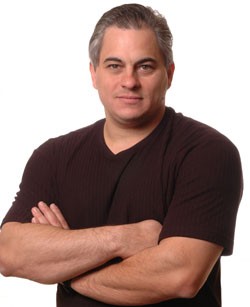|
Body Lift operations are really extensions of the "Tummy Tuck." Liposuction is a great operation for the patient with good or "tight" skin tone, however excessive loose skin must be addressed as well (when present) to achieve significant change:
- Severe laxity of the skin in a body area indicates that liposuction alone may leave excess skin that remains after healing "hanging"
- In the case of Abdominoplasty, the abdomen is treated with actual "tightening" of the abdominal muscles (which is not a part of other body lift procedures).
- In other Body Lift procedures, the removal of both fat and skin results in the improvement of both issues.
|
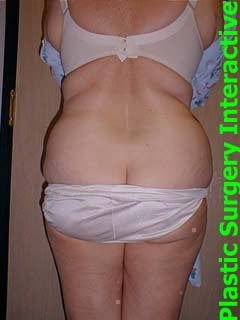 |
These operations are named based upon the regions addressed:
I. For the Tummy and "Around the Back"
This is the most commonly requested area for body lift surgery as Tummy Tuck surgery is the operation upon which body lift is based. I divide the treatment of the abdomen and back into two operations. I believe this to be best in the sense that making an incision all the way around the body in one sitting is morbid and can leave an unacceptably high risk of wound complications. Most patients appropriate for body lift (many times those that have lost extreme amounts of weight) are good candidates for several operations. Staging multiple large operations so that the patient doesn't undergo too much at once is the safest way to proceed.
Operation: Extended High Lateral Tension Tummy Tuck
This operation takes the correction across the abdomen toward the flanks. The incisions end where the table meets the back with the patient lying on her back. An example with images is online here. This leaves the back toward the buttocks unoperated. It also gives the patient an area upon which to lie in recuperating from this very large Tummy Tuck operation.
II. For the "Backside"
Operation: Butt Lift
This is the second half of the abdominal body lift. I sometimes end up performing this for patients upon whom I did not do the Tummy Tuck, such as in the first case:

Before |
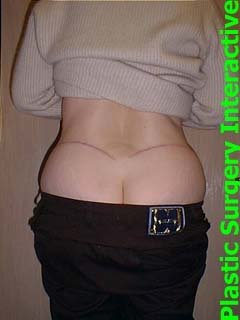
5 Months Later |
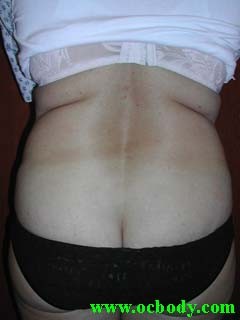
Before |
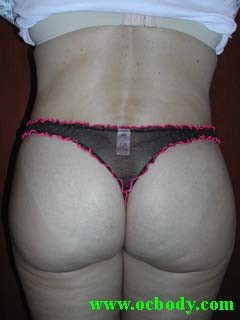
6 Weeks Later |
The story on patients seeking this operation is usually similar. They have had a Tummy Tuck and despite exercise and weight loss have persistent fatty bulges and skin excess in the flanks. The top patient here also had had liposuction (by another surgeon) two times following her Tummy Tuck with disappointing results. The problem here is the combination of skin and fat. Each of these tissues needs to be addressed to obtain improvement. The skin of their "tummies" had been tightened during their tummy tuck operations years before. Frequently after a Tummy Tuck, liposuction can improve the result. In these cases, however, there was just too much skin in the flanks for liposuction alone to be adequate. This skin was removed with additional fat during their buttock lifts (really flank lifts).
At the right above, the patients appear with improved flank contour. The wounds are healing. Scars in this operation like those in abdominoplasty take a full year (some times a year and a half) to mature at which time they generally fade. These patients were more than happy to exchange their flank fullness for the scars even before they had improved.
III. For The Inside of the Thighs
Operation: Medial Thigh Lift
This is the second most commonly requested area for body lift surgery (after Tummy Tuck) and an area in which liposuction commonly contributes. The skin of the inner thigh is one of the first areas in which skin laxity demonstrates itself. Remember that liposuction does not really address the skin. If skin tone is at all loose, then liposuction in the inner thigh should be minimal or withheld entirely unless additional skin (and usually fat) removal is added to "take up the slack."
The usual medial thigh lift involves an incision in the groin in the crease between the groin and the thigh. Liposuction is used further down the thigh. In cases in which there is simply too much skin (frequently in gastric bypass patients), an additional incision must be placed down the thigh. This can show in the upper inner thigh although this improves with time. The patient below appears before and 1 month after her extended medial thigh lift (the additional incision was needed to take up the slack here). She had had a gastric bypass some two years prior to this operation.
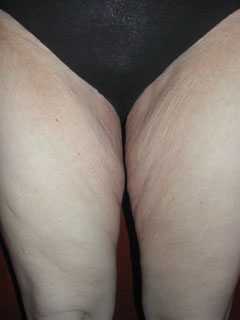
Before |
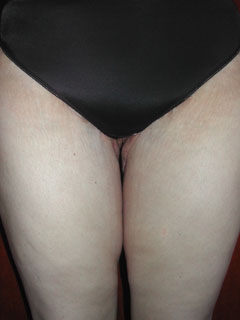
1 Month Later |
More
Body Lift surgery tends to be demanding on both the patient and surgeon. Many surgeons don't perform these operations for this reason. Following is a brief synopsis of important issues:
- Liposuction - This is frequently used to improve the appearance of the areas adjacent to the skin reduction. Just as in a tummy tuck, limiting liposuction in the field of the skin reduction is reasonable to improve wound healing. Wound problems are related to healing and infection which is reduced when liposuction is not performed in these areas. This can lead to a wish for liposuction six months to year later once the wound has healed to "fine tune" the result. It also leads to less problems with the patient healing after the body lift surgery. A reasonable compromise.
- The Scar - This is often the limiting issue for the patient considering Body Lift surgery. These scars are long and take time (sometimes over a year) to mature.
- Numbness and Swelling - These operations involve removing large portions of skin and moving tissues around quite a bit. Numbness in these areas will be present after surgery. Some of it will resolve. Swelling while the tissues heal usually takes several months to start resolving, but at times nearly a year to cease.
- Tissue Relaxation - The potential for tissues to relax months after surgery after being made so tight that they nearly do not close is a constant source of frustration for surgeons and patients. In body lift surgery this can lead to the desire for additional surgery later down the line. This is particularly the case for the patient following gastric bypass (weight reduction) surgery. Incisions never seem long enough and tissues relax to an almost impossible extent. Take this into account before you decide to have surgery as surgeons no matter how skilled cannot defeat physics.
- These operations take the surgeon between three and six hours to perform. They are generally performed under general anesthesia. To do so under less of an anesthetic would be cruel and unusual punishment in my opinion.
Risks and Benefits
The operations have several degrees of severity. A Medial Thigh Lift is less of a big deal than a Full Lower Body Lift involving the flanks, buttocks and abdomen (this is kinda like a "Tummy Tuck" that includes the backside as well). Thigh lift patients tend to feel more "inconvenienced" though as their wounds are near undergarments and can rub. Each of these operations is more serious than simple liposuction. The tightening of the area treated, while it allows for a more radical contour improvement, leaves longer wounds which take time to heal. The average patient tends to be "taken aback" for a few days to a week feeling more "normal" after 4-6 weeks. Patients with pre-existing illness such as diabetes and obesity tend to take longer to heal and can have less-than-optimal healing. In patients looking to have this procedure, a look into that patient's overall health is indicated.
Post-operatively, I almost always (except in small procedures in young people) insist upon some sort of aftercare arrangement. This constitutes an overnight stay (at least) in a facility with nursing available. The first few times out of bed may take a little help. Although the patient may not want to get up, it is important to do so soon after surgery. Family members tend to think the patient should be in bed. A skilled nurse knows better.
When patients do go home, it might be a few weeks until they are back to regular activity. I recommend no heavy exercise for six to eight weeks. Each case is judged indivdually. I do however like the patient up and walking taking deep breaths from the morning after surgery.
Patients can have problems with wound healing (as mentioned above). Wounds can break down requiring wound care for a few weeks and potentially more surgery months or a year later. Wound healing can be delayed in those patients that smoke, have diabetes or are taking steroids. Many patients will want additional work done at a later date as body lifts improve the areas treated fairly dramatically and adjoining areas sometimes "pale by comparison." For these adjacent areas liposuction later can be helpful. Some surgeons will opt to do all these procedures at once, but to optimize wound healing minimizing liposuction in key areas is advised.
More rare complications (really the complications of a large operation) include venous thrombosis (the development of vein clots in the legs). This is one reason it makes sense not to be still in bed as these clots tend to develop in patients at rest. These clots rarely can break off from the veins and result in serious problems.
MAIN
AFTER WEIGHT LOSS
© John Di Saia, MD... an Orange County California Plastic Surgeon
Serving Southern California since 1997 * (949) 369-5932
|
|
| |
| |
Please note that this resource is offered freely to individuals considering cosmetic body surgery. No rights are granted and it is not to be reprinted or copied without the author's prior written consent. Understand that some of the information presented may be a matter of professional opinion. Although efforts have been made to assure accuracy, no guarantees are expressed or implied.
|
|
|
| |
|

